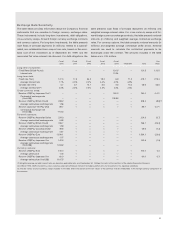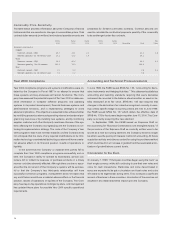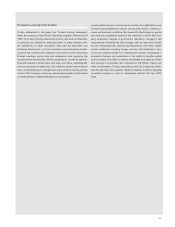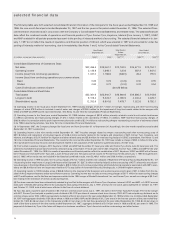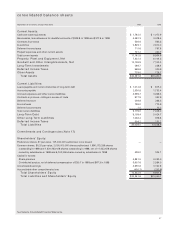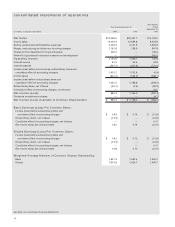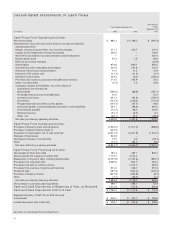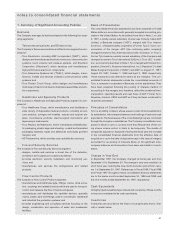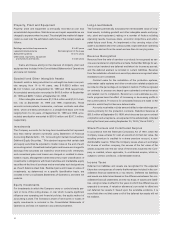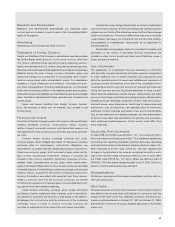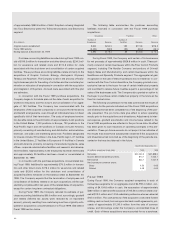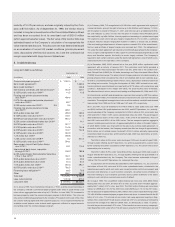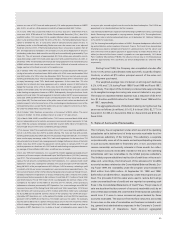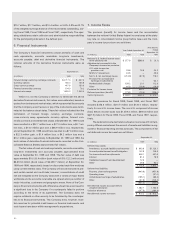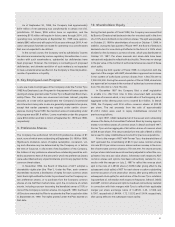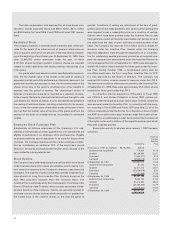ADT 1999 Annual Report Download - page 45
Download and view the complete annual report
Please find page 45 of the 1999 ADT annual report below. You can navigate through the pages in the report by either clicking on the pages listed below, or by using the keyword search tool below to find specific information within the annual report.
43
Research and Development
Research and development expenditures are expensed when
incurred and are included in cost of sales in the Consolidated State-
ments of Operations.
Advertising
Advertising costs are expensed when incurred.
Translation of Foreign Currency
Assets and liabilities of the Company’s subsidiaries operating outside
the United States which account in a functional currency other than
U.S. dollars, other than those operating in highly inflationary environ-
ments, are translated into U.S. dollars using year-end exchange rates.
Revenues and expenses are translated at the average exchange rates
effective during the year. Foreign currency translation gains and
losses are included as a component of accumulated other compre-
hensive income (loss) within shareholders’ equity. For subsidiaries
operating in highly inflationary environments, inventories and prop-
erty, plant and equipment, including related expenses, are translated
at the rate of exchange in effect on the date the assets were acquired,
while other assets and liabilities are translated at year-end exchange
rates. Translation adjustments for these operations are included in net
income (loss).
Gains and losses resulting from foreign currency transac-
tions, the amounts of which are not material, are included in net
income (loss).
Financial Instruments
From time to time the Company enters into a variety of forward foreign
currency exchange contracts, cross-currency swaps, currency
options, forward commodity contracts and interest rate swaps in its
management of foreign currency and commodity exposures and inter-
est costs.
Forward foreign currency exchange contracts and cross-
currency swaps, which mitigate the impact of changes in currency
exchange rates on intercompany cross-border obligations, are
accounted for consistent with the related intercompany transactions.
Under cross-currency swaps, which principally hedge certain net for-
eign currency denominated investments, changes in valuation are
included in the currency translation adjustment component of accu-
mulated other comprehensive income (loss) within shareholders’
equity. The interest differentials on cross-currency swaps are included
in interest expense. Forward foreign currency exchange contracts and
currency options, acquired for the purpose of reducing exposure to
currency fluctuations associated with expected cash flows denomi-
nated in currencies other than the functional currencies, are marked
to market with realized and unrealized gains or losses reflected in sell-
ing, general and administrative expenses.
Under forward commodity contracts, which hedge anticipated
purchases of certain metals and other materials used in manufactur-
ing operations, payments are received or paid based on the differen-
tial between the contract price and the actual price of the underlying
commodity. Gains or losses on forward commodity contracts are
recorded as adjustments to the value of the purchased commodity.
Interest rate swaps hedge interest rates on certain indebtedness
and involve the exchange of fixed and floating rate interest payment
obligations over the life of the related agreement without the exchange
of the notional amount. The interest differentials to be paid or received
under interest rate swaps are recognized over the life of the underly-
ing agreement or indebtedness, respectively, as an adjustment to
interest expense.
Receivables and payables related to unrealized increases and
decreases in the values of derivative financial instruments are
included in other current assets and other current liabilities, respec-
tively, and are not material.
Use of Estimates
The preparation of consolidated financial statements in conformity
with generally accepted accounting principles requires management
to make extensive use of certain estimates and assumptions that
affect the reported amount of assets and liabilities and disclosure of
contingent assets and liabilities at the date of the consolidated finan-
cial statements and the reported amounts of revenues and expenses
during the reported periods. Significant estimates in these consoli-
dated financial statements include merger, restructuring and other
non-recurring charges, purchase accounting reserves, allowances for
doubtful accounts receivable, estimates of future cash flows associ-
ated with assets, asset impairments, useful lives for depreciation and
amortization, loss contingencies, net realizable value of inventories,
estimated contract revenues and related costs, environmental liabili-
ties, income taxes and tax valuation reserves, and the determination
of discount and other rate assumptions for pension and post-retire-
ment employee benefit expenses. Actual results could differ from
those estimates.
Accounting Pronouncements
In June 1998, the FASB issued SFAS No. 133, “Accounting for Deriv-
ative Instruments and Hedging Activities.” This statement establishes
accounting and reporting standards requiring that every derivative
instrument be recorded on the balance sheet as either an asset or lia-
bility measured at its fair value. SFAS No. 133 also requires that
changes in the derivative’s fair value be recognized currently in earn-
ings unless specific hedge accounting criteria are met. In June 1999,
the FASB issued SFAS No. 137 which defers the effective date of
SFAS No. 133 to fiscal years beginning after June 15, 2000. The Com-
pany is currently analyzing this new standard.
Reclassifications
Certain prior year amounts have been reclassified to conform with cur-
rent year presentation.
Stock Splits
Per share amounts and share data have been retroactively restated to
give effect to the reverse stock split effected in connection with the
merger of ADT and Former Tyco referred to in Note 2, and the two-for-
one stock splits distributed on October 22, 1997 and October 21, 1999,
both effected in the form of a stock dividend (See Note 10 for further
discussion).


